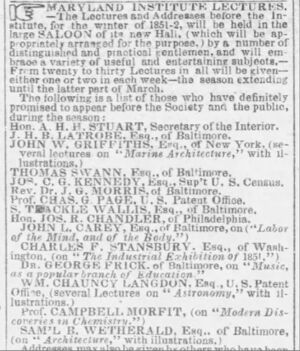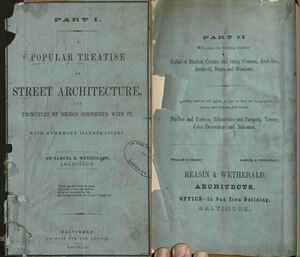Samuel Brook Wetherald (1825-1854)
Samuel Brook Wetherald was born in Washington D. C. on July 12, 1825, the son of the Quaker Minister Thomas Wetherald (1791-1832) and Ann Earnshaw Wetherald (1789-1857). He lectured on architecture at the Maryland Institute while he resided at Rachel Price's boarding house at 18 South Calvert. He practiced as an architect in partnership with W. H. Reasin in Baltimore from about 1851 until 1853. He died on October 10, 1854. While he is buried in Sandy Spring, Montgomery County, he was last listed as dwelling on South Paca Street, Baltimore, and his son, Samuel Jr., was baptized in the Swedenborgian New Jerusalem Church in1855. Samuel Jr., was later longtime postmaster of Sandy Spring.
The architect George A. Frederick, misspelling Reasin and Wetherald's names, reflected on their work in Baltimore in his 1912 unpublished memoir dictated to J. B. Noel Wyatt, who was then President of the Baltimore Chapter of the AIA:
- Rasin and Wetherall did quite a large amount of work here. Mr. Wetherall, who unfortunately died at a comparatively early age, had a distinctive individuality, and by many years anticipated the famous "Richardson' in his pronounced preference and exemplification of the Italian (as distinguished from the more E. Byzantine of the same period), Romanesque style of architecture. Much of Rasin and Wetheral's work shows this preferential tendency. Their principal works were the Maryland Institute and Centre Market building; the Independent or Firehouse No. 6 Fire-engine house, Gay and Ensor Streets; the old "Bible House", W. Fayette, E. of Charles Street; the Noah Walker buildings, the earliest on the S.W. corner of Baltimore and Hanover Streets, the later one on the south side of Baltimore near Calvert with an "L" on the latter street. The former on the third floor level contained a central niche filled by a replica of "Crawford's Washington, (now placed in Druid Hill -Park) also the Granger building, S.W. corner of Baltimore and Sharp Streets; Excepting the fire-engine house, all of these buildings unfortunately fell as victims to the destructive fury of the great fire of 1904. The dwelling houses of Mr. Saml. Shoemaker, N. E. corner of St. Paul and Reade Streets; and that of Mr. Caughy, on W. side of St. Paul near Eager Street, also emanated in this office.
- The year before he died, Wetherald published his thoughts on street architecture in an illustrated pamphlet that examined the streetscapes of New York, Philadelphia, Baltimore, and Washington. He certainly had a distinctive individuality in criticizing the work of his competitors and their patrons.
- Ed Papenfuse, 11/5/2022

